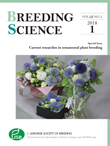Volume 68, Issue 1
Displaying 1-16 of 16 articles from this issue
- |<
- <
- 1
- >
- >|
Cover
-
2018Volume 68Issue 1 Pages cover
Published: 2018
Released on J-STAGE: April 14, 2018
Download PDF (1322K)
Editorial
-
2018Volume 68Issue 1 Pages 1
Published: 2018
Released on J-STAGE: April 10, 2018
Download PDF (500K) Full view HTML
Reviews
-
2018Volume 68Issue 1 Pages 3-13
Published: 2018
Released on J-STAGE: April 10, 2018
Advance online publication: February 17, 2018Download PDF (3803K) Full view HTML -
2018Volume 68Issue 1 Pages 14-24
Published: 2018
Released on J-STAGE: April 10, 2018
Advance online publication: February 20, 2018Download PDF (3511K) Full view HTML -
2018Volume 68Issue 1 Pages 25-34
Published: 2018
Released on J-STAGE: April 10, 2018
Advance online publication: March 15, 2018Download PDF (5040K) Full view HTML -
2018Volume 68Issue 1 Pages 35-52
Published: 2018
Released on J-STAGE: April 10, 2018
Advance online publication: March 08, 2018Download PDF (3725K) Full view HTML -
2018Volume 68Issue 1 Pages 53-61
Published: 2018
Released on J-STAGE: April 10, 2018
Advance online publication: February 20, 2018Download PDF (9315K) Full view HTML -
2018Volume 68Issue 1 Pages 62-70
Published: 2018
Released on J-STAGE: April 10, 2018
Advance online publication: February 17, 2018Download PDF (766K) Full view HTML -
2018Volume 68Issue 1 Pages 71-78
Published: 2018
Released on J-STAGE: April 10, 2018
Advance online publication: February 17, 2018Download PDF (695K) Full view HTML -
2018Volume 68Issue 1 Pages 79-87
Published: 2018
Released on J-STAGE: April 10, 2018
Advance online publication: February 17, 2018Download PDF (4396K) Full view HTML -
2018Volume 68Issue 1 Pages 88-98
Published: 2018
Released on J-STAGE: April 10, 2018
Advance online publication: February 24, 2018Download PDF (3703K) Full view HTML -
2018Volume 68Issue 1 Pages 99-108
Published: 2018
Released on J-STAGE: April 10, 2018
Advance online publication: February 27, 2018Download PDF (5054K) Full view HTML -
2018Volume 68Issue 1 Pages 109-118
Published: 2018
Released on J-STAGE: April 10, 2018
Advance online publication: February 22, 2018Download PDF (2972K) Full view HTML -
2018Volume 68Issue 1 Pages 119-127
Published: 2018
Released on J-STAGE: April 10, 2018
Advance online publication: February 17, 2018Download PDF (2127K) Full view HTML -
2018Volume 68Issue 1 Pages 128-138
Published: 2018
Released on J-STAGE: April 10, 2018
Advance online publication: March 02, 2018Download PDF (8969K) Full view HTML
Note
-
2018Volume 68Issue 1 Pages 139-143
Published: 2018
Released on J-STAGE: April 10, 2018
Advance online publication: February 27, 2018Download PDF (2164K) Full view HTML
- |<
- <
- 1
- >
- >|

